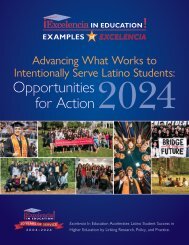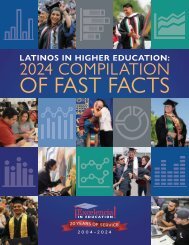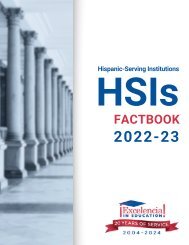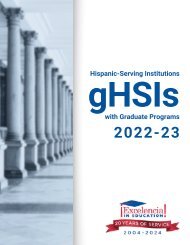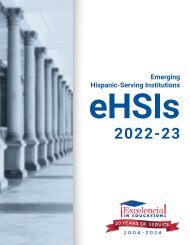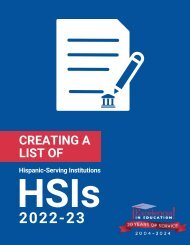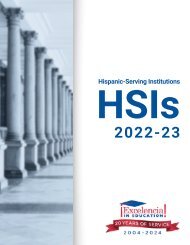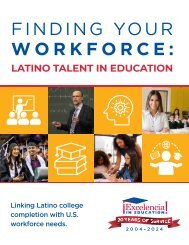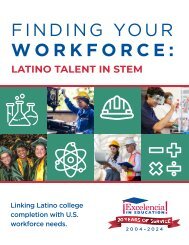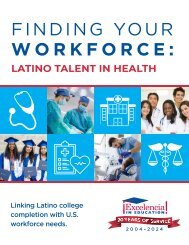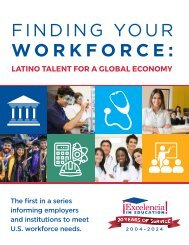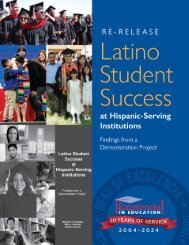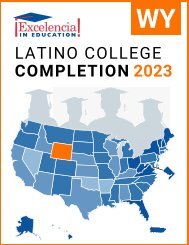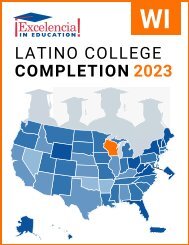Latino College Completion 2023: Nebraska
You also want an ePaper? Increase the reach of your titles
YUMPU automatically turns print PDFs into web optimized ePapers that Google loves.
NE
LATINO COLLEGE COMPLETION:<br />
NEBRASKA – <strong>2023</strong><br />
For the U.S. to regain the top ranking in the world for college degree<br />
attainment, <strong>Latino</strong>s will need to earn 6.2 million degrees by 2030. 1<br />
FAST FACTS<br />
STATE RANKING:<br />
<strong>Nebraska</strong> had the 35th largest<br />
<strong>Latino</strong> population in the U.S.<br />
K-12 POPULATION:<br />
In <strong>Nebraska</strong>, 17% of the K-12<br />
population was <strong>Latino</strong>. 2<br />
POPULATION:<br />
In <strong>Nebraska</strong>, 12% of the population<br />
was <strong>Latino</strong>. 2<br />
MEDIAN AGE:<br />
The median age<br />
of Hispanics<br />
in <strong>Nebraska</strong> was<br />
24, compared<br />
to 40 for White<br />
non-Hispanics. 2<br />
24<br />
Hispanics<br />
40<br />
White<br />
non-Hispanics<br />
ENROLLMENT:<br />
In <strong>Nebraska</strong>, 23% of Hispanics<br />
(ages 18 to 34) were enrolled in higher<br />
education, compared to 26% of<br />
White non-Hispanics. 2<br />
DEGREE ATTAINMENT:<br />
In <strong>Nebraska</strong>, 23% of Hispanic<br />
adults (25 and older) had earned an<br />
associate degree or higher, compared to<br />
48% of White non-Hispanic adults. 2<br />
Hispanic Adults = 2.3 of 10<br />
To reach the degree attainment goal by 2030, the U.S. can: close<br />
the degree completion gap by accelerating <strong>Latino</strong> completion while<br />
increasing for all students and scale up programs and initiatives that<br />
work for <strong>Latino</strong>, and all, students. The following demographics,<br />
institutional data, and practices inform <strong>Latino</strong> degree attainment.<br />
ENROLLING: Top 5 Institutions (Hispanic Undergraduates) in <strong>Nebraska</strong>, 2021-22<br />
Institution<br />
Sector<br />
Grand Hispanic %<br />
Total Total Hispanic<br />
1 University of <strong>Nebraska</strong> at Omaha Public, 4-year 12,010 1,943 16%<br />
2 University of <strong>Nebraska</strong>-Lincoln Public, 4-year 19,448 1,613 8%<br />
Private not-forprofit,<br />
4-year<br />
3 Bellevue University<br />
8,903 1,312 15%<br />
4 Metropolitan Community <strong>College</strong> Area Public, 2-year 6,467 1,112 17%<br />
5 Central Community <strong>College</strong> Public, 2-year 3,477 1,045 30%<br />
ASSOCIATE DEGREES: Top 5 Institutions Awarding to Hispanics in <strong>Nebraska</strong>, 2020-21<br />
Institution<br />
Sector<br />
Grand<br />
Total<br />
NOTE: We use the terms <strong>Latino</strong> and Hispanic interchangeably in this factsheet.<br />
Hispanic<br />
Total<br />
Source: Excelencia in Education analysis using U.S. Department of Education, National Center for<br />
Education Statistics (NCES), Integrated Postsecondary Education Data System (IPEDS), 2021 Fall<br />
Enrollment, Graduation Rates Survey and Institutional Characteristics Survey.<br />
%<br />
Hispanic<br />
1 Metropolitan Community <strong>College</strong> Area Public, 2-year 1,420 161 11%<br />
2 Central Community <strong>College</strong> Public, 2-year 675 134 20%<br />
3 Southeast Community <strong>College</strong> Area Public, 2-year 1,051 98 9%<br />
4 Northeast Community <strong>College</strong> Public, 2-year 740 82 11%<br />
5 Western <strong>Nebraska</strong> Community <strong>College</strong> Public, 2-year 176 38 22%<br />
BACHELOR DEGREES: Top 5 Institutions Awarding to Hispanics in <strong>Nebraska</strong>, 2020-21<br />
Institution<br />
Sector<br />
Grand<br />
Total<br />
Hispanic<br />
Total<br />
%<br />
Hispanic<br />
Private not-forprofit,<br />
4-year<br />
1 Bellevue University<br />
2,334 275 12%<br />
2 University of <strong>Nebraska</strong>-Lincoln Public, 4-year 4,311 249 6%<br />
3 University of <strong>Nebraska</strong> at Omaha Public, 4-year 2,438 126 5%<br />
Private not-forprofit,<br />
4-year<br />
4 Creighton University<br />
1,173 89 8%<br />
5 University of <strong>Nebraska</strong> at Kearney Public, 4-year 871 81 9%<br />
White Adults = 4.8 of 10<br />
1 Projections to 2030: Excelencia in Education. (2020). Ensuring America’s Future: Benchmarking <strong>Latino</strong><br />
<strong>College</strong> <strong>Completion</strong> to 2030. Excelencia in Education. Washington, D.C.<br />
2 U.S. Census Bureau, 2021 American Community Survey 1-Year Estimates
<strong>Nebraska</strong> Gap in Degree <strong>Completion</strong><br />
Closing the degree completion gap can be tracked<br />
by the 4 measures shown below. Alone, none<br />
of these measures capture the entire “story” of<br />
degree completion. However, in combination,<br />
they provide a useful picture of the gap in degree<br />
attainment between Hispanic and White non-<br />
Hispanic cohorts in a single year.<br />
Graduation Rate — Total percentage of students<br />
who graduated within 150% of normal time for<br />
first-time, full-time freshmen. This incorporates<br />
students that graduated in 3 years at two-year<br />
institutions, or in 6 years at four-year institutions.<br />
Transferred to Another Institution —<br />
Percentage of students that transferred to another<br />
institution and did not complete a degree.<br />
Still Enrolled — Percentage of students that are<br />
still enrolled at the point of 150% normal time to<br />
completion.<br />
No Longer Enrolled — Percentage of students<br />
that are no longer enrolled at the point of 150%<br />
normal time to completion.<br />
At two-year institutions, Hispanics’<br />
graduation rate was 16%-points<br />
lower than that of their White<br />
non-Hispanic peers in <strong>Nebraska</strong>.<br />
TWO-YEAR INSTITUTIONS<br />
34%<br />
6%<br />
16%<br />
44%<br />
WHITE<br />
-16%<br />
48%<br />
10%<br />
14%<br />
28%<br />
HISPANIC<br />
DEGREE OUTCOMES<br />
■ No Longer Enrolled<br />
■ Still Enrolled<br />
■ Transferred to<br />
Another Institution<br />
■ Graduation Rate<br />
*Percentages may not add up to 100% due to rounding.<br />
At four-year institutions, Hispanics’<br />
graduation rate was 15%-points<br />
lower than that of their White<br />
non-Hispanic peers in <strong>Nebraska</strong>.<br />
FOUR-YEAR INSTITUTIONS<br />
2%<br />
13%<br />
63%<br />
WHITE<br />
-15%<br />
17%<br />
48%<br />
HISPANIC<br />
NOTE: Outcomes shown are for students at two-year institutions who started in Fall 2018, and<br />
for students at four-year institutions who started in Fall 2015.<br />
Source: Excelencia in Education analysis using the U.S. Department of Education, National<br />
Center for Education Statistics (NCES), Integrated Postsecondary Education Data System, 2021<br />
Graduation Rates Survey and the Institutional Characteristics Survey.<br />
23%<br />
4%<br />
30%<br />
Examples of What Works for <strong>Latino</strong> Students<br />
There are institutions showing success in enrolling, retaining, and graduating <strong>Latino</strong> students. The following are examples of<br />
programs across the country with evidence of effectiveness in serving <strong>Latino</strong> students nominated for Examples of Excelencia.<br />
The Center for Educational Partnerships at California State University-<br />
Fullerton provides opportunities for middle and high school students<br />
to successfully progress onto college/navigate higher education and<br />
supports undergraduate students through postbaccalaureate preparation.<br />
The Educational Partnership’s goals are to: improve student graduation,<br />
postsecondary and postbaccalaureate enrollment rates; increase knowledge<br />
of postsecondary and postbaccalaureate options, preparation, and financing<br />
among students and families; engage in active collaboration with community<br />
partners, educational institutions, and families through a multi-faceted<br />
approach to strengthen equitable access and supports; develop learning<br />
opportunities for students that provide them skills and knowledge to<br />
become self-advocates and leaders in their communities. Established in 2007,<br />
California State University-Fullerton’s Division of Student Affairs created the<br />
department to coordinate three TRIO grants: GEAR UP, Upward Bound,<br />
and Talent Search. Undergraduates receive support through the Ronald E.<br />
McNair Postbaccalaureate Achievement Program. The Center also leads<br />
campus efforts through four intersegmental partnerships and five initiatives<br />
with non-profit community-based organizations, local school districts,<br />
and community colleges to intentionally develop early interventions and<br />
practices that prepare students for a range of college and career options. All<br />
programs provided are culturally-sensitive and recognize the need to engage<br />
Latinx families as a whole and provide bilingual services.<br />
Since it’s inception the program has served over 26,000 students<br />
and over 18,500 (70%) of them were <strong>Latino</strong> participants. Of 2019<br />
graduating Upward Bound scholars, 97% enrolled in an institution of<br />
postsecondary education immediately after high school graduation<br />
compared to 66% of all 2019 California graduating high school<br />
students. Similarly, 85% of Talent Search scholars in 2019 enrolled in<br />
an institution of postsecondary education immediately after high school<br />
graduation. In Fall 2018, 100% of graduating McNair Scholars were<br />
accepted to and enrolled in graduate studies immediately following<br />
completion of their bachelor’s. In 2018, 83% of McNair Scholars in<br />
their first year of graduate school persisted to their second year.<br />
For more information on institutional programs improving <strong>Latino</strong> student success in higher education, access Excelencia in<br />
Education’s Growing What Works database at http://www.edexcelencia.org/growing-what-works<br />
ENSURING AMERICA’S FUTURE BY INCREASING LATINO COLLEGE COMPLETION • WWW.EDEXCELENCIA.ORG




